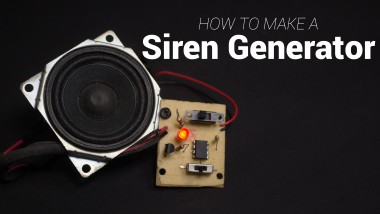How To Make A Siren Generator
About the project
Learn How to Make a DIY Electronic Siren Generator circuit that can produce police car siren, emergency ambulance siren & fire brigade sound using the IC UM3561a Siren Tone Generator.
Project info
Items used in this project
Story
Learn How to Make a DIY Electronic Siren Generator circuit that can produce police car siren, emergency ambulance siren & fire brigade sound using the IC UM3561a Siren Tone Generator.
The circuit only requires a few components and can be put together in a couple of hours. Since the siren is multipurpose, it can be easily configured to suit it's vehicle's siren requirements.
Don't forget to Subscribe for more projects: YouTube
Step 1: Parts & Tools
Components:
- 1x UM3561 AliExpress
- 1x BC547 NPN Transistor AliExpress
- 1x 220KΩ Resistor AliExpress
- 2x 220Ω Resistor AliExpress
- 1x 5mm LED AliExpress
- 1x SPDT Slider Switch AliExpress
- 1x SP3T Slider Switch AliExpress
- 2x 2-Pin Male Header Pins AliExpress
- 1x Speaker AliExpress
- 1x AA Battery Holder (2 Slot) AliExpress
- 2x AA Battery AliExpress
Tools:
- Soldering Iron AliExpress
- Soldering Wire AliExpress
You can also Buy the PCB: PCBWay
Step 2: UM3561 Explained





The UM3561 is a low-cost, low power CMOS LSI designed for use in toy applications. Since the integrated circuit includes oscillating and selector circuits, a compact sound module can be constructed with only a few additional components. The UM3561 contains a programmed mask ROM to electronically reproduce alarm sounds.
Step 3: Circuit Schematic
Only one of the Siren tunes can be played at a time. This is determined on the basis of the position of the SP3T Slide switch. The switch has three positions which will connect the common terminal with VCC, GND or NC in order to fulfill the Truth Table.
The 220KΩ resistor is used to set the oscillating frequency of the IC.
A dynamic speaker is driven with an external NPN transistor. An SPDT switch is used to turn the circuit ON & OFF.
Eagle Schematic: GitHub
Step 4: PCB Fabrication


Order PCB: PCBWay
Eagle PCB Board Layout: GitHub
Printable PDF: GitHub
I fabricated the board using the Iron Method.
I drilled four mounting holes in each corner with a diameter of 3mm.
The PCB size is 3.3cm X 3.3cm .
Step 5: Circuit Assembly

Place and solder all the components onto the PCB. Double check components with polarities. Lastly, solder the Power adapter and speaker to the PCB.
Step 6: Support These Projects

YouTube: Electro Guruji
Instagram: @electroguruji
Twitter: ElectroGuruji
Facebook: Electro Guruji
Instructables: ElectroGuruji
Are you an engineer or hobbyist who has a great idea for a new feature in this project? Maybe you have a good idea for a bug fix? Feel free to grab the schematics from GitHub and tinker with it.
If you have any questions/doubts related to this project, leave them in the comments section and I will try my best to answer them.
























Leave your feedback...